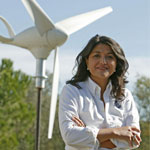Getting large amounts of wind power into the grid
 In just a few weeks Copenhagen will be a hive of wind energy activity as EWEA’s annual conference and exhibition gets going. In the run-up to the event, the EWEA blog spoke to Ana Estanqueiro, Chair of a session aimed at discovering how to integrate large amounts of wind power into Europe’s grids…
In just a few weeks Copenhagen will be a hive of wind energy activity as EWEA’s annual conference and exhibition gets going. In the run-up to the event, the EWEA blog spoke to Ana Estanqueiro, Chair of a session aimed at discovering how to integrate large amounts of wind power into Europe’s grids…
What are the main obstacles in Europe to integrating large amounts of wind power?
The main barriers these days are much less on the “hardware” side (access to transmission and distribution grids) and much more on the “software” side: grid-operation principles and electricity market rules. These are currently not well adapted to wind power and need to evolve in order to smoothly incorporate wind-powered electricity. Today, difficulties related to grid access are largely for offshore projects where investments are extremely high and usually need to be coordinated with other economic sectors.
Denmark is often cited as an example country for integrating large amounts of wind power, what in your opinion are the key things the country did to achieve this?
That’s a difficult question to answer since Denmark developed this sector much earlier than the rest of Europe and used very different incentives (essentially a compulsory minimum share of renewable energies rather than just a favourable support system). But Denmark’s – and other wind energy pioneering countries’ – main achievement is an approach that recognises the economic, social and environmental benefits of wind energy – essentially what the wind industry can bring to the country.
In just a few words I would say that Danish leaders showed a very rare capability in the 80s and 90s – a very long term and extremely sharp vision!
Today, Europe gets around 6.5% of its electricity from wind power, how do you see this increasing over the next decade?
Before the current financial and economic crises, I was expecting wind power to reach between 18% and 20%, very close to EWEA’s own targets. As the current situation spreads across Europe I anticipate now that wind power will at least double the current level of electricity provided and, if no other unexpected events occur, reach close to 15% by the end of the decade. That would be an excellent number and a great achievement for the wind sector – a consequence of its maturity and resilience.
How big a problem do you think public acceptance is?
Public acceptance is a real and serious issue that should be dealt with great care. These days everybody wants to use “green energy”, but if people hear or see a wind turbine from their home they can become “less green”. We need to be understanding and inclusive in these situations: nobody should be forced to accept a lower perceived quality of life and it is the role of wind researchers and engineers to produce even more silent and elegant wind turbines. Meanwhile, people should hear about the benefits of renewable energy. I usually joke saying that the only thing wind engineers will not be able to do, is to produce transparent wind turbines, but thinking again, why not?
What do you hope to get out of EWEA 2012 in Copenhagen?
EWEA is extremely important for discussion and for discovering the most relevant and essential R&D issues. Therefore I expect to refresh my knowledge on the whole wind sector by attending the plenary sessions and by visiting the exhibition as well as discussing the recent R&D trends in grid integration – my own area of research.
If you are keen to learn more on how large amounts of wind energy can be integrated into the grid, make sure you attend Ana’s session at EWEA 2012 in Copenhagen on 17 April!
Find out more about power grids and the electricity market on www.freedomforelectricity.eu






